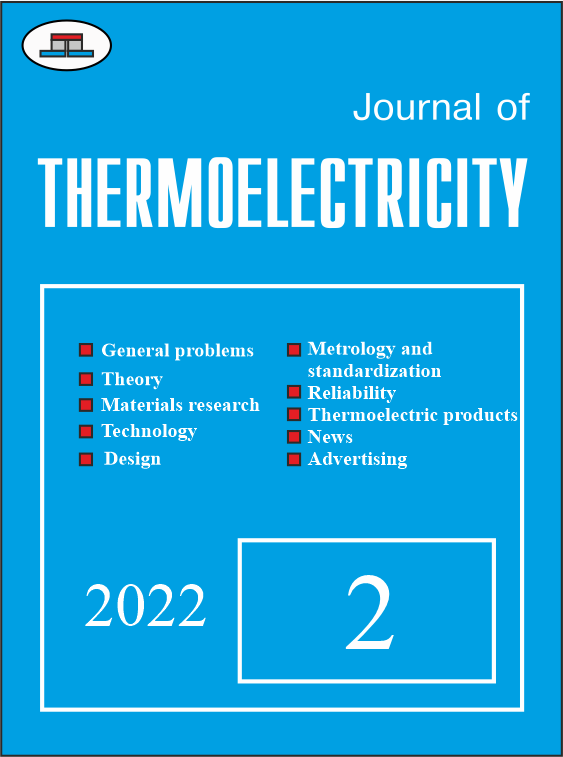Effect of leg thickness and heat carrier velocity on the efficiency of a permeable generator thermoelement
DOI:
https://doi.org/10.63527/1607-8829-2022-1-44-54Keywords:
permeable thermoelement, computer simulation, electric energy generation, energy characteristicsAbstract
The paper presents the results of computer research on the influence of leg thickness and gas pumping velocity for a 3D model of a permeable generator thermoelement on the EMF and efficiency. The dependences of the energy characteristics of a thermoelement made of materials based on Bi-Te-Se-Sb are calculated.
References
Anatychuk L.I. (1979). Termoelementy i termoelektricheskiie ustroistva. Spravochnik. [Thermoelements and thermoelectric devices. Reference book]. Kyiv [in Russian].
Anatychuk L.I. (2008). Termoelektrichestvo. T.1. Fizika termoelektrichestva [Thermoelectricity. Vol.1. Physics of Thermoelectricity]. Chernivtsi [in Russian].
Snyder G.J., Toberer E.S. (2008). Complex thermoelectric materials. Nature Materials, 7, 105 – 114.
Anatychuk L.I. (2007). Current status and some prospects of thermoelectricity. J.Thermoelectricity, 2, 7 – 20.
Anatychuk L. I., Vikhor L. N., Cherkez R. G. (2000). Optimal control of semiconductor material inhomogeneity for permeable cooling thermocouples. J.Thermoelectricity, 3, 45 – 55.
Anatychuk L.I., Cherkez R.G., Demyanyuk D.D., Bukharayeva N.R. (2012). Research on the energy characteristics of a permeable planar thermoelement. J.Thermoelectricity, 2, 88 – 92.
Anatychuk L.I., Semeniuk V.A. (1992). Optimalnoiie upravleniie svoistvami termoelektricheskikh materialov i priborov [Optimal control over the properties of thermoelectric materials and devices]. Chernivtsi: Prut [in Russian].
Kadenko I.M., Kharitonov O.M., Yermolenko R.V. [2010]. Osnovy teplohidravliky yadernykh energetychnykh ustanovok [Fundamentals of thermal hydraulics of nuclear power plants]. Kyiv: VPC “Kyiv University” [in Ukrainian].
Okhrimenko D.I. (2009). The use of COMSOL Multiphysics 3.4 package for solving hydrodynamics and heat exchange problems in chemical technology: Course paper. D.
Biriulin G.V. (2006). Thermophysical calculations in the COMSOL/FEMLAB finite element package: A Guidebook. St-Petersburg: ITMO University [in Russian].




